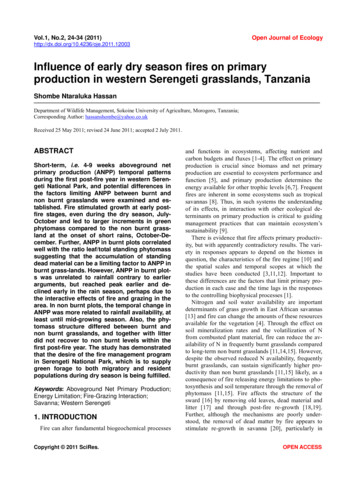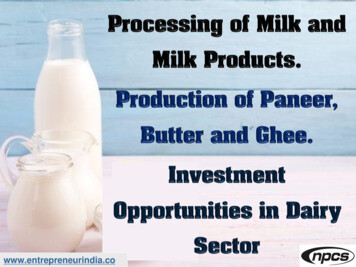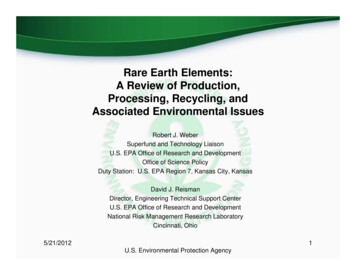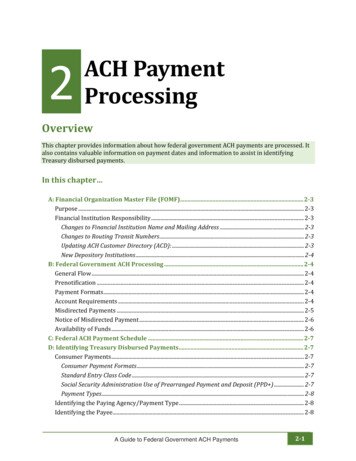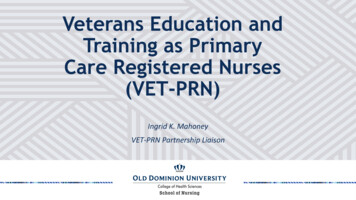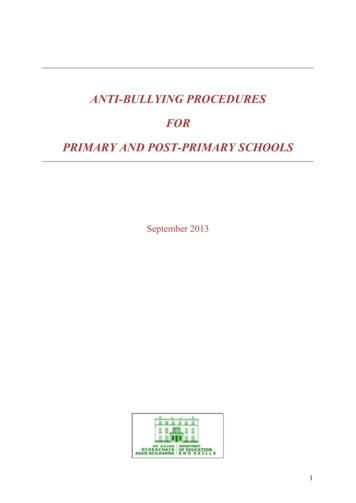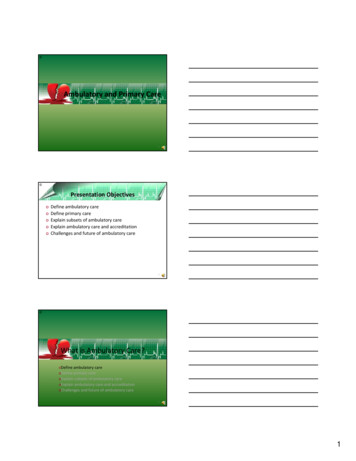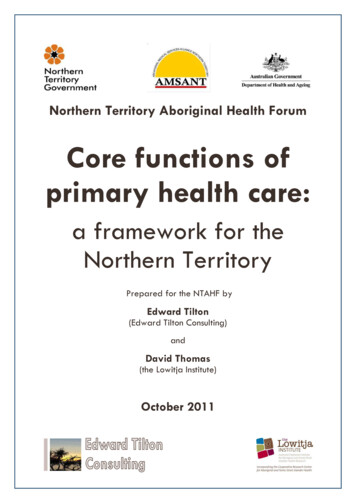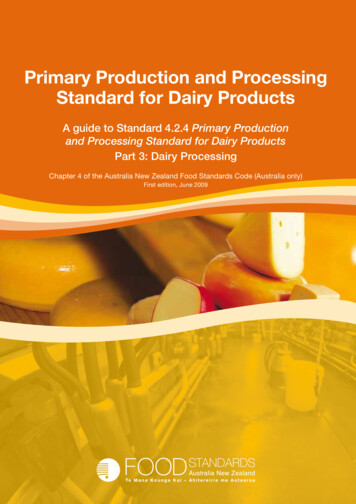
Transcription
Primary Production and ProcessingStandard for Dairy ProductsA guide to Standard 4.2.4 Primary Productionand Processing Standard for Dairy ProductsPart 3: Dairy ProcessingChapter 4 of the Australia New Zealand Food Standards Code (Australia only)First edition, June 2009
FOODSTANDARDSAustralia New ZealandA guide to Standard 4.2.4 Primary Productionand Processing Standard for Dairy ProductsPart 3: Dairy ProcessingChapter 4 of the Australia New Zealand Food Standards Code (Australia only)First edition, June 2009
iiFOOD STANDARDS AUSTRALIA NEW ZEALANDPART 3: DAIRY PROCESSING Food Standards Australia New Zealand 2009ISBN 978-0-642-34567-7This work is copyright. Apart from any use as permitted under the Copyright Act 1968, no part may be reproduced by any processwithout prior written permission from Food Standards Australia New Zealand. Requests and inquiries concerning reproduction andrights should be addressed to the Information Officer, Food Standards Australia New Zealand, PO Box 7186, Canberra BC,ACT 2610.Food Standards Australia New ZealandFSANZ AustraliaPO Box 7186Canberra BC ACT 2610AustraliaFSANZ New ZealandPO Box 10599, The TerraceWellingtonNew ZealandTel: 61 2 6271 2222Fax 61 2 6271 2278Email info@foodstandards.gov.auTel 64 4 473 9942Fax 64 4 473 9855Email info@foodstandards.govt.nzPART 3: DAIRY PROCESSING
PART 3: DAIRY PROCESSINGFOOD STANDARDS AUSTRALIA NEW ZEALANDContentsIntroduction1What is the purpose of the guide?1What is the scope of the guide?1What is the legal status of the guide?1How do I use the guide?1Background3The Australia New Zealand Food Standards Code3Chapter 4 Primary Production and Processing Standards3Standard 4.2.4 Primary Production and Processing Standard for Dairy Products4Standard 4.2.4 Primary Production and Processing Standard for Dairy Products6Interpretation of Standard 4.2.4 Primary Production and Processing Standardfor Dairy Products, Divisions 1 and 312Division 1 — on 4 — Dairy processing1812 Application1813 Controlling food safety hazards1814 Product Tracing3015 Processing of milk and dairy products3116 Processing of dairy products to make cheese and cheese products34Appendix 1 – Dairy food safety program resources developed byAustralian governments36Appendix 2 – Heat Treatment Equivalents to Pasteurisation forCommon Types of Dairy Produce37Appendix 3 – Standard 4.2.4A Primary Production and Processing Standardfor Specific Cheeses38GUIDE TO STANDARD 4.2.4iii
ivFOOD STANDARDS AUSTRALIA NEW ZEALANDPART 3: DAIRY PROCESSINGPART 3: DAIRY PROCESSING
FOOD STANDARDS AUSTRALIA NEW ZEALANDPART 3: DAIRY PROCESSINGIntroductionWhat is the purpose of the guide?This guide to Standard 4.2.4 Primary Production and Processing Standard for Dairy Products has been developedby Food Standards Australia New Zealand (FSANZ) as one of its functions under section 13(1)(c) of the Australia NewZealand Food Authority Act 1991. It is intended to help with the interpretation of Standard 4.2.4 in Chapter 4 of theAustralia New Zealand Food Standards Code (the Code). A copy of Standard 4.2.4 is included in this guide atpages 6 to 11.What is the scope of the guide?This guide has been developed to help government agencies responsible for enforcing the requirements of Standard4.2.4 to understand the general intent of individual clauses in the standard. It does this by providing an explanationof individual provisions and includes examples where appropriate. Enforcement officers seeking further clarification ofdefinitions or requirements in the Code should approach the relevant agency in the state or territory.The guide may also be useful to dairy businesses. It does not specify how dairy businesses must comply with therequirements of the standard but the explanations and examples provided may help them to comply.What is the legal status of the guide?The guidance provided in the guide is not legally binding - only the clauses in the standard are legally binding. Personswho are uncertain about the meaning of a clause in Standard 4.2.4 can refer to the explanation in the guide forclarification.The guide includes examples that may be helpful in explaining the meaning of a clause. However, neither theexplanations nor the examples in the guide are legal requirements for dairy businesses. The examples given in thisguide are used to illustrate how the clause might applyDairy businesses seeking guidance on compliance with the standard should contact their local enforcement agencyfor advice.How do I use the guide?Standard 4.2.4 contains requirements for dairy primary production businesses (Division 2), dairy transport businesses(Division 3) and dairy processing businesses (Division 4). The guide to the standard has been developed in three parts this is Part 3: Dairy Processing requirements.11The other parts are Part 1: Dairy Primary Production Requirements and Part 2: Dairy Collection andTransport RequirementsGUIDE TO STANDARD 4.2.41
2FOOD STANDARDS AUSTRALIA NEW ZEALANDPART 3: DAIRY PROCESSINGThis guide aims to provide an explanation of each clause of the standard that applies to dairy processing businesses(covering Divisions 1 and 4 of the standard). This interpretation, beginning with the definitions in Standard 4.2.4 beginson page 12. A copy of the complete standard is on pages 6 to 11.The guide provides an explanation of each clause of the standard in the same order in which they appear in thestandard. The legal requirements are provided in bold type followed by a description of the intended food safetyoutcome (or other outcome as appropriate) and an explanation of the requirement, as outlined below.LEGAL REQUIREMENTINTENDED OUTCOMEEXPLANATION OF REQUIREMENTTerms in the standard are explained under the interpretation clauses and the clauses where they are used. Analphabetical listing of defined terms, including applicable definitions from Chapter 2 and Chapter 3, is in the Glossary.PART 3: DAIRY PROCESSING
FOOD STANDARDS AUSTRALIA NEW ZEALANDPART 3: DAIRY PROCESSINGBackgroundThe Australia New Zealand Food Standards CodeFSANZ is a statutory authority that works in partnership with the Australian government, state and territorygovernments, and the New Zealand government to set food standards. Food standards are contained in the Code,which is divided into chapters: Chapter 1 of the Code contains general food standards that apply to all foods (for example labelling) Chapter 2 contains compositional standards for particular classes of foods (for example meat and meat products) Chapters 3 and 4 contain food safety requirements for the production and processing of food, and requirements forpremises and vehicles used for food production. Chapters 3 and 4 do not apply in New Zealand.2The food standards in the Code are incorporated into state, territory and (with exceptions) New Zealand legislation, andare legal requirements on food businesses. Because food standards are given legal effect by state, territory and NewZealand legislation, the Code must be read in conjunction with the relevant legislation.The Code, and information about the Code, is available on the FSANZ website at www.foodstandards.gov.au .Information can also be obtained from the FSANZ Information Officer on (02) 6271 2241, or email info@foodstandards.gov.au . Information on the Food Standard Australia New Zealand Act 1991 can be obtainedfrom www.comlaw.gov.au.Chapter 4 Primary Production and Processing StandardsIn August 2002 the Australia and New Zealand Food Regulation Ministerial Council adopted a whole-of-chain approachto food safety in Australia. FSANZ was given responsibility for developing national food safety requirements for theprimary production end of the supply chain—primary production and processing standards—for inclusion in the Code.Chapter 4 is a new chapter in the Code and includes the standards for primary production and processing of food.FSANZ has developed primary production and processing standards for seafood and dairy products, and is working onstandards for poultry meat and eggs.Primary production and processing standards are developed with regard to the Australia and New Zealand FoodRegulation Ministerial Council’s Overarching Policy Guideline on Primary Production and Processing Standards.3FSANZ develops primary production and processing standards using scientific risk analysis and wide consultation withstakeholders. A standards development committee is established for each primary production and processing standarddeveloped. The committee members are representatives from industry, consumer bodies, research organisations andgovernments.23Information about dairy regulation in New Zealand is available on the New Zealand Food Safety Authority’swebsite at www.nzfsa.govt.nz .The Overarching Policy Guideline on Primary Production and Processing Standards is available on theFood Standards Australia New Zealand website at www.foodstandards.gov.au and the Department of Health and Ageing’s website at www.health.gov.au .GUIDE TO STANDARD 4.2.43
4PART 3: DAIRY PROCESSINGStandard 4.2.4 Primary Production and Processing Standard for Dairy ProductsStandard 4.2.4 Primary Production and Processing Standard for Dairy Products was gazetted on 5 October 2006.There is a two-year implementation period for the standard, which means that dairy businesses were required tocomply with the standard from 5 October 2008.Application dates may vary between states and territories as they enact legislation to apply the standard to dairybusinesses.Standard 4.2.4 sets out a number of food safety requirements for dairy primary production businesses (coveringon-farm milk production activities), dairy transport businesses (covering the collection and bulk transport of milk anddairy products) and dairy processing businesses (covering activities up to, but not including, retail). Distribution of dairyproducts and retail sale activities are covered by the requirements of Chapter 3 of the Code (Standard 3.2.2and Standard 3.2.3).Under Standard 4.2.4, dairy businesses are required to control the potential food safety hazards associated with theirbusiness by implementing a documented food safety program. Particular measures that should be covered by the foodsafety program are also specified.The requirements for dairy primary production businesses, dairy transport businesses and dairy processing businessesare set out in separate divisions of the standard: Division 1 — Preliminary Division 2 — Dairy primary production requirements Division 3 — Dairy collection and transport Division 4 — Dairy processing.This guide covers the requirements for dairy processing businesses (Division 4). Separate guides cover therequirements for Divisions 2 and 3.PART 3: DAIRY PROCESSING
FOOD STANDARDS AUSTRALIA NEW ZEALANDPART 2: DAIRY COLLECTION AND TRANSPORT REQUIREMENTSStandard 4.2.4Primary Productionand Processing Standard for Dairy ProductsGUIDE TO STANDARD 4.2.45
6FOOD STANDARDS AUSTRALIA NEW ZEALANDPART 3: DAIRY PROCESSINGStandard 4.2.4Primary Production and Processing Standard for Dairy Products(Australia Only)Commenced on 5 October 2008Purpose and commentaryThis Standard sets out a number of food safety requirements, including the implementation of documented food safetyprograms for dairy primary production, collection, transportation and processing. However, this Standard does notapply to retail sale activities. Chapter 3 of this Code covers retail sale activities.Table of ProvisionsDivision 1 — Preliminary1Interpretation2ApplicationDivision 2 — Dairy primary production requirements3Controlling food safety hazards4Specific requirements5Tracing6Skills and knowledgeDivision 3 — Dairy collection and transportation7Controlling food safety hazards8Specific requirements9Product tracing10 Time and temperature controls11 Skills and knowledgeDivision 4 — Dairy processing12 Application13 Controlling food safety hazards14 Product tracing15 Processing of milk and dairy products16 Processing of dairy products to make cheese and cheese productsPART 3: DAIRY PROCESSING
FOOD STANDARDS AUSTRALIA NEW ZEALANDPART 3: DAIRY PROCESSINGClausesDivision 1 — Preliminary1 Interpretation(1) Unless the contrary intention appears, the definitions in Chapters 2 and 3 ofthis Code apply to this Standard.(2) In this Standard –Authority means the State, Territory or Commonwealth government agency or agencies having the legal authorityto implement and enforce this Standard.control measure means a measure that prevents, eliminates or reduces to an acceptable level, a food safety hazard.dairy primary production means the production of milk or colostrum for further processing for human consumptionand includes the keeping, grazing, feeding and milking of animals and the storage of milk on the premises at whichthe animals were milked.dairy primary production business means a business, enterprise or activity that involves dairy primary production.dairy processing includes the manufacture of dairy products.dairy processing business means a business, enterprise or activity that involves dairy processing.dairy products include –(a) milk; and(b) colostrum; and(c) liquid milk products; and(d) cream and thickened cream; and(e) butter, butter concentrate, buttermilk, concentrated buttermilk, dairy blend, ghee, and anhydrous milk fat(butter oil);(f) casein, caseinate, and cheese; and(g) whey, whey cream and concentrated whey cream; and(h) cultured milk and yoghurt; and(i) ice-cream and ice-cream mix; and(j) buttermilk powder, lactose powder, milk sugar, powdered milk, skim milk powder, whey powder, milk proteinpowder and other milk concentrates.dairy transport business means a business, enterprise or activity involving the collection and transport of milk fromthe dairy primary production business to the processing business or the transport of bulk milk or dairy productsbetween dairy processors.inputs includes any feed, water and chemicals, includ
16 Processing of dairy products to make cheese and cheese products 34 Appendix 1 – Dairy food safety program resources developed by Australian governments 36 Appendix 2 – Heat Treatment Equivalents to Pasteurisation for Common Types of Dairy Produce 37 Appendix 3 – Standard 4.2.4A Primary Production and Processing Standard for Specific Cheeses 38. FOOD STANDARDS AUSTRALIA NEW ZEALAND .File Size: 1MBPage Count: 46
